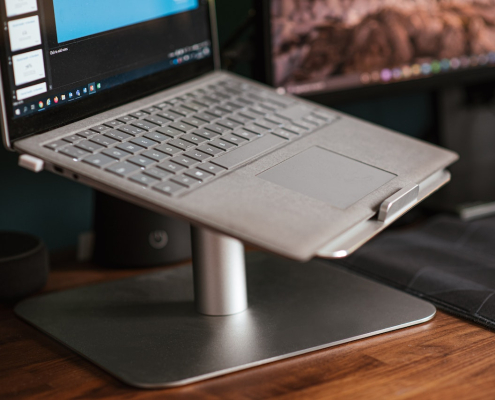The shift to remote work has rapidly increased in recent years, with more people working from home than ever before. As a result, it’s essential to create a comfortable and efficient workspace that promotes productivity and prevents work-related strain and injuries. In this article, we will discuss the importance of ergonomics in relation to working from home and provide practical tips for designing an ergonomic home office.
What is Ergonomics?
Ergonomics is the scientific discipline that studies the interaction between humans and their work environment. It aims to design and arrange workspaces, systems, and tasks in such a way that they optimise human well-being and overall performance. By incorporating ergonomic principles into your home office, you can improve your comfort, reduce the risk of injury, and enhance your productivity.
Choosing the Right Equipment
Investing in ergonomic equipment is crucial for creating a comfortable and efficient home office. Here are some essential pieces of equipment to consider:
Don’t Use A Laptop (for long periods)!
Laptops have become increasingly popular due to their portability, convenience, and ever-growing capabilities. While they are undoubtedly useful for many tasks, they are not the best option for prolonged work sessions.
One of the primary drawbacks of using a laptop for extended work sessions is its inherently poor ergonomics. Laptops are designed to be compact and portable, which results in a compromise on ergonomics. Some of the ergonomic challenges posed by laptops include:
Screen Height

Laptops are one of the main causes of neck and back pain when working from home.
Laptop screens are typically lower than eye level, causing users to bend their necks and tilt their heads downward to view the screen. This awkward posture can lead to neck strain, muscle tension, and potential long-term damage.
Keyboard & Trackpad Placement
Laptop keyboards and trackpads are usually small and cramped, which can result in awkward hand and wrist positioning. This may contribute to the development of repetitive strain injuries, such as carpal tunnel syndrome and tendonitis.
Smaller Screen Size
Laptops typically have smaller screens compared to desktop monitors, which can strain the eyes and decrease productivity. Smaller screens may require users to squint or lean forward to see text and images clearly, leading to eye strain, headaches, and poor posture.
Fixed Design
Unlike desktop computers, laptops do not offer the flexibility to adjust the position of the screen, keyboard, or trackpad individually. This limitation makes it challenging to achieve an ideal ergonomic setup, which can lead to discomfort and potential injuries over time.
If you must use a laptop, there are ways to improve your ergonomic setup:
Use an External Monitor, Keyboard, and Mouse
Connecting an external monitor, keyboard, and mouse to your laptop can significantly improve its ergonomics. This setup allows you to position the screen at eye level and use a full-sized keyboard and mouse for more comfortable hand and wrist positioning.
Invest in a Laptop Stand
A laptop stand elevates your laptop screen to a more ergonomic height, reducing neck strain and promoting better posture. Pair the stand with an external keyboard and mouse for an even more comfortable setup.

Laptop stands are a simple and cost-effective way to improve your ergonomic setup.
Use a Docking Station
A docking station allows you to connect your laptop to multiple peripherals, such as an external monitor, keyboard, and mouse, with a single connection. This can streamline your workspace and make it easier to transition between a portable and stationary work setup.
These adjustments will vastly improve the ergonomic environment.
However, ideally, you should…
Use A Desktop Computer
Using a desktop PC removes virtually all of the fundamental problems associated with laptops. Desktops offer:
- Larger screen/s.
- Capacity to easily raise and reposition the monitor.
- Ability to adjust the placement of the mouse, keyboard and other peripherals.
Desktops also generally provide superior performance, so you can complete work tasks more efficiently.
Ergonomic Office Chair
A comfortable and supportive office chair is crucial for maintaining good posture, preventing work-related injuries, and ensuring productivity while working from home. Some key features of a great home office chair include:
Lumbar Support
A good home office chair should provide adequate lumbar support to maintain the natural curve of your lower back. This helps prevent slouching and reduces the risk of developing back pain. Look for chairs with adjustable lumbar support, which allows you to customise the fit according to your body shape and preferences.

Lumbar support is a crucial element of any office chair.
Adjustable Seat Height
An adjustable seat height is essential for ensuring that your feet rest comfortably on the floor and your thighs are parallel to the ground. This position helps promote proper blood circulation and reduces the pressure on your lower back. Opt for chairs with a pneumatic adjustment lever, which allows you to easily change the seat height to suit your needs.
Seat Depth & Width
The ideal chair should have a seat that is wide and deep enough to accommodate your body comfortably. A seat that is too shallow may cause pressure on the back of your thighs, while a seat that is too deep can limit your ability to use the chair’s backrest properly. Look for chairs with adjustable seat depth to tailor the fit according to your body dimensions.
Adjustable Armrests
Adjustable armrests help support your arms and shoulders, reducing strain on your neck and upper back. They should allow your elbows to rest comfortably at a 90-degree angle while typing or performing other tasks. Look for chairs with armrests that can be adjusted in height, width, and angle for optimal customisation.
Quality Material
Choose a chair made from high-quality, breathable materials that provide comfort and durability. Mesh or fabric upholstery can offer better airflow and prevent overheating during long work sessions, while leather or faux leather options may provide a more luxurious feel and be easier to clean.
Swivel and Casters
A swivel function and smooth-rolling casters make it easy to move around your workspace without straining your body. This feature is particularly important if you frequently need to switch between tasks or reach items on different areas of your desk.
Weight Capacity
Ensure that the chair you choose has a suitable weight capacity to accommodate your body safely and comfortably. Most office chairs have a standard weight capacity of around 250 pounds, but heavier-duty options are available for individuals who require additional support.
Recline & Tilt Mechanisms
Recline and tilt mechanisms allow you to adjust the chair’s backrest angle and tension, promoting movement and reducing the risk of stiffness from prolonged sitting. Look for chairs with adjustable recline and tilt features to help maintain comfort and support throughout your workday.
Aesthetics
While functionality should be the priority, the appearance of your office chair can also impact your satisfaction and motivation. Choose a chair that complements your home office’s overall design and style to create a cohesive and visually appealing workspace.
Warranty and Return Policy
A good warranty and return policy can provide peace of mind when investing in a home office chair. Look for chairs with a comprehensive warranty covering parts and workmanship, and ensure that the retailer offers a fair return policy in case the chair does not meet your expectations.
Adjustable Desk
An adjustable desk is not essential, but is a valuable addition to any home office. Standing desks, in particular, can help dampen the risks associated with prolonged sitting, such as obesity, heart disease, and diabetes. Look for a desk with an easy-to-use height adjustment mechanism and a spacious surface for your computer and other office essentials.
Correcting Your Workspace Layout
A well-organised workspace layout can significantly impact your productivity and overall well-being. Keep these factors in mind when arranging your home office:
Monitor Placement
Position your computer monitor at eye level or slightly below to reduce eye strain and neck discomfort. The ideal distance between your eyes and the screen should be about an arm’s length. If you’re using multiple monitors, place them close together to minimise head movement and use the primary monitor for your most frequent tasks.

Keeping the monitor at an appropriate can reduce both neck and eye strain.
Keyboard & Mouse Placement
Your keyboard and mouse should be at a comfortable height, allowing your elbows to maintain a 90-degree angle while typing. Additionally, consider using ergonomic keyboards and mice designed to encourage a natural hand and wrist position, which can help prevent carpal tunnel syndrome and other repetitive strain injuries.
Adequate Lighting
Proper lighting is essential for ameliorating eye strain and maintaining good overall health. Natural light is ideal, so place your desk near a window if possible. If natural light is insufficient, use adjustable task lighting to focus on your work area and avoid screen glare. Additionally, consider using a desk lamp with adjustable brightness settings and a color temperature that mimics natural daylight.
Incorporate Movement & Breaks
Prolonged sitting has been linked to various health issues, including obesity, heart disease, and diabetes. To counteract these risks, it’s essential to incorporate movement and breaks into your work-from-home routine.
Regular Breaks
Take regular breaks throughout your workday to rest your eyes, stretch your muscles, and give your mind a chance to recharge. Experts recommend the 20-20-20 rule: every 20 minutes, take a 20-second break, and look at something 20 feet away. This helps reduce eye strain and gives your body a chance to adjust.
Stretching and Exercise
Incorporate stretching and light exercise into your work breaks to improve blood flow and reduce muscle tension. Simple stretches targeting your neck, shoulders, back, and legs can help alleviate discomfort and prevent work-related injuries. Additionally, consider incorporating short walks or more vigorous exercise during longer breaks to further enhance your physical and mental well-being.
Personalising Your Workspace
A comfortable and inspiring workspace can have a positive impact on your productivity and overall mood. Consider these tips for personalising your home office:
Choose Colours Wisely
Select colours that encourage focus and calmness, such as blues, greens, or muted earth tones. Avoid bright, bold colours that may cause distraction or overstimulation. If you have the freedom to paint your home office, consider using a soothing colour palette that promotes concentration and relaxation.
Organise and Declutter
A clutter-free workspace helps reduce distractions and promotes a more focused work environment. Use desk organisers, shelves, and storage solutions to keep your office essentials within reach and maintain a clean and tidy workspace.
Add Personal Touches
Incorporate personal touches into your home office, such as artwork, plants, or family photos, to create a space that feels welcoming and inspiring. Additionally, consider using ergonomic and aesthetically pleasing office accessories to further enhance your workspace’s visual appeal and functionality.
Addressing Noise Distractions
Noise distractions can significantly impact your concentration and productivity while working from home. Consider the following strategies to minimise disruptions and create a quiet workspace:
Soundproofing
Invest in soundproofing materials, such as acoustic panels or curtains, to minimise external noise and create a more peaceful work environment. Alternatively, you can use bookshelves, rugs, and other soft furnishings to absorb sound and reduce echo.

Quality headphones are a wise investment for those who work remotely often.
Use Noise-Canceling Headphones
Noise-canceling headphones can help you block out distractions and maintain focus on your work. Look for comfortable, high-quality headphones with adjustable noise-canceling settings to suit your preferences.
Set Boundaries with Family Members
Establish and communicate clear boundaries with family members or housemates to minimise interruptions during your work hours. Consider using visual cues, such as a closed door or a “do not disturb” sign, to signal when you are working and require quiet.
Avoiding Eye Strain
Eye strain is a common issue experienced by individuals who spend long hours working or studying in front of screens or reading materials. It can cause discomfort, fatigue, and even headaches. There are several measures one can take to reduce eye strain:
Follow the 20-20-20 Rule
To reduce eye strain, follow the 20-20-20 rule: every 20 minutes, take a 20-second break, and look at something 20 feet away. This helps relax your eye muscles and gives your eyes a chance to adjust to different focal lengths.
Adjust Screen Brightness and Contrast
Ensure that your screen’s brightness and contrast settings are adjusted appropriately to minimise eye strain. The brightness should be balanced with the ambient lighting in your room, while the contrast should be set at a comfortable level to easily distinguish text and images.
Use Proper Lighting
Avoid working in overly bright or dimly lit environments, as they can contribute to eye strain. Aim for balanced, indirect lighting that minimises glare and shadows. Natural light is ideal, but if it’s insufficient, use adjustable task lighting to focus on your work area.
Minimise Screen Glare
Screen glare can cause eye strain and discomfort. To reduce glare, position your monitor at a right angle to windows or other light sources. You can also use an anti-glare screen protector or adjust your screen settings to minimise reflections.
Maintain Proper Viewing Distance and Position
Keep your screen at a comfortable viewing distance, typically around an arm’s length away. Position the top of the screen at or slightly below eye level to prevent unnecessary neck strain. If you wear bifocals or progressive lenses, you may need to adjust the screen height accordingly to find the most comfortable viewing angle.
Increase Text Size and Adjust Font Settings
Reading small text for extended periods can contribute to eye strain. Increase the text size on your screen and adjust font settings to improve readability. Choose a font style that is easy to read, and consider using dark text on a light background, which tends to be easier on the eyes.
What To Do If You Experience Pain While Working
If you experience pain while working, the first thing to do is to see a health professional to assess the issue. Pain can have many causes and its important to get expert advice. Early intervention is often far more efficient and effective than leaving an issue for months or years. If the issue is related to your posture and ergonomics, a physiotherapist can provide appropriate treatment and guidance.
The Final Word on WFH Ergonomics
Creating an ergonomic home office is essential for maintaining your health, well-being, and productivity while working from home. By investing in ergonomic furniture, optimising your workspace layout, incorporating movement and breaks, personalising your work environment, and addressing noise distractions, you can create a comfortable and efficient workspace that supports your success.
Remember, it’s crucial to listen to your body and make adjustments as needed. By continually refining your home office setup, you can ensure it remains a comfortable and productive space that supports your well-being and work performance.


